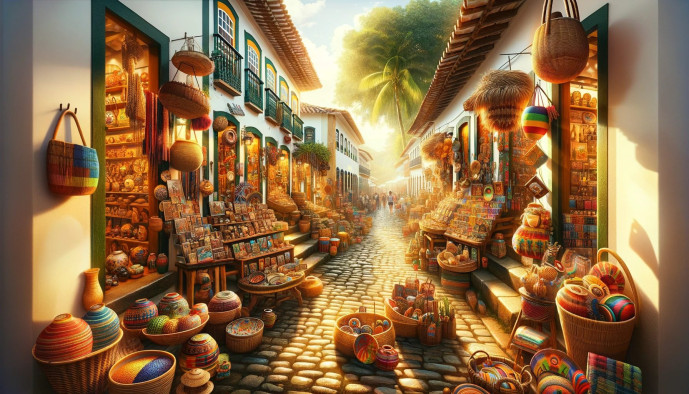Handcraft, Shopping and Souvenirs to bring back from Brazil
Explore Brazil's unique handicrafts, best shopping spots, and must-have souvenirs.

Essentials
Smart Shopping: Tips for a Great Souvenir Experience
Where to Find Authentic Goods
-
Feiras Hippies (Hippie Fairs): These are typically weekly open-air markets and are excellent venues for discovering a wide range of artisan goods, from leatherwork and jewelry to paintings and clothing. They offer a direct connection to local artists. Noteworthy examples include the famous Feira Hippie de Ipanema in Rio de Janeiro, held on Sundays, and the fair at Praça da República in São Paulo.
-
Mercados Municipais (Municipal Markets): These are bustling, covered markets that serve as the gastronomic and cultural heart of many Brazilian cities. Beyond fresh produce, they are prime locations for finding regional crafts, high-quality artisanal cachaça, and local spices to take home. The Mercado Municipal in São Paulo is a particularly grand and comprehensive example.
-
Specialized Artisan Shops & Co-ops: For guaranteed authentic indigenous crafts, seek out government-supported shops, such as those run by FUNAI (the National Indian Foundation), or artisan cooperatives. These establishments ensure that the profits go directly to the indigenous communities and that the crafts are genuine representations of their culture.
-
Boutiques and Designer Stores: For those interested in contemporary Brazilian culture, urban centers host numerous boutiques featuring modern design. Here you can find higher-end fashion, unique jewelry, and sophisticated home goods that reflect Brazil’s vibrant contemporary art scene.
Bargaining, Payment, and Etiquette
-
Haggling Culture: In informal settings like street markets and feiras, bargaining is a common and accepted part of the transaction. It is not, however, appropriate in formal shops, boutiques, or restaurants. A polite starting point is to offer 20-30% less than the initial asking price and negotiate from there.
-
Payment Methods: Cash, specifically the Brazilian Real (R$), is the preferred method of payment at markets and with smaller vendors. While larger, established stores readily accept major credit cards, it is always wise to carry some local currency. Remember to inform your bank of your travel dates to avoid any interruption in card services.
-
Asking for a “Desconto”: To initiate a negotiation, you can politely ask, “Tem desconto?” (Is there a discount?). A slightly more informal and friendly alternative is, “Faz um precinho melhor?” (Can you do a better price?). A smile and a respectful tone are always your best tools.
Spotting Quality and Authenticity
-
Look for the Artisan: Often, the highest quality items are sold by the individuals who made them. If possible, engage with the vendor and ask about their craft. This not only helps you appreciate the item’s story but is also a good indicator of its authenticity.
-
Check for “Made in Brazil” Labels: This is a simple yet effective way to verify the origin of an item, particularly for textiles, packaged foods, and manufactured goods like footwear. It helps ensure you are not inadvertently purchasing an import.
-
Indigenous Crafts: To ensure that indigenous artisans are fairly compensated for their intricate work, it is best to purchase these items from reputable cooperatives, certified shops like those from FUNAI, or, when possible, directly from the communities themselves during a guided visit.
Packing and Customs
-
Fragile Items: For delicate souvenirs like ceramics or wood carvings, ask the vendor to wrap them securely. It can also be prudent to bring a small amount of bubble wrap from home for valuable pieces, providing an extra layer of protection in your luggage.
-
Restrictions: Be aware of your home country’s customs regulations. There are often restrictions on bringing back organic materials such as untreated wood, seeds, fresh plants, and certain animal products, including feathers from protected bird species. A quick check of your government’s customs website before you shop can prevent disappointment at the border.
Regional Specialties: What to Buy and Where
The Northeast (Bahia, Pernambuco, Ceará)
-
Figa Charms: A classic Bahian souvenir, the figa is an amulet in the shape of a clenched fist, with the thumb tucked between the index and middle fingers. Typically carved from wood or jacaranda, it is a traditional symbol of good luck meant to ward off evil spirits.
-
Lace (Renda): The states of Ceará and Alagoas are renowned for their tradition of intricate, handmade lacework. You will find exquisite tablecloths, clothing inserts, and decorative pieces, each showcasing a delicate and time-honored craft.
-
Hammocks (Redes): The Northeast is the best place to find durable, comfortable, and vibrantly colored hand-woven hammocks. They are a central part of life in the region and make for a wonderfully practical and beautiful souvenir.
-
Clay Figurines: From the area of Alto do Moura in Pernambuco, a region famous for its ceramic artists, come charming and detailed clay figurines. These pieces often depict scenes of rural life, local folklore, and musicians with remarkable personality.
-
Berimbau: This single-string percussion instrument is the soulful heart of capoeira music. Originating in Bahia, a handcrafted berimbau is a unique and authentic piece of Afro-Brazilian culture.
The Amazon (Amazonas, Pará)
-
Indigenous Crafts: The Amazon is home to a rich diversity of indigenous cultures. Look for beautiful woven baskets, jewelry made from seeds and beads, carved wooden masks, and distinctive pottery from communities such as the Ticuna and Yan